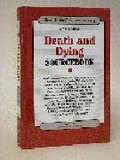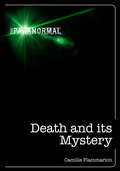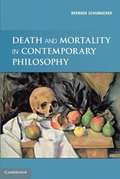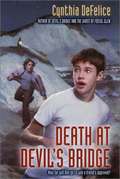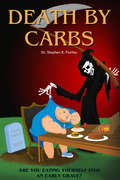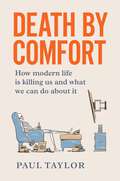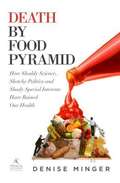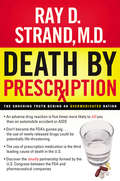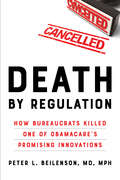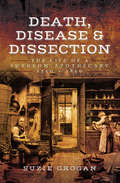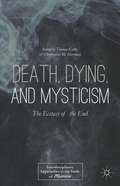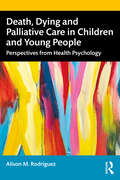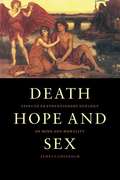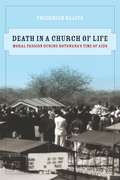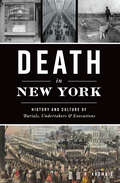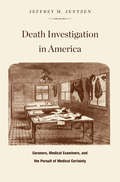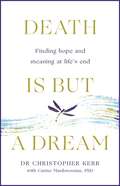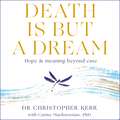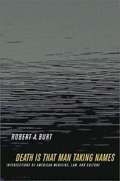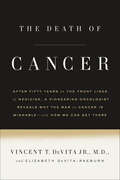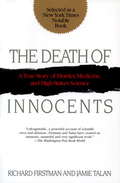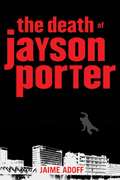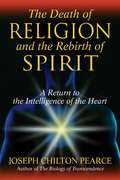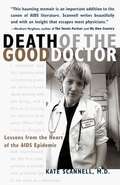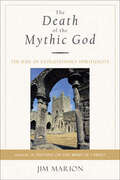- Table View
- List View
Death and Dying Sourcebook
by Annemarie S. MuthThis volume compiles 55 documents and excerpts from government agencies and copyrighted material from organizations and individual. They cover death and dying statistics in the US, attitudes, health care options for the terminally ill, end-of-life medical care, approaching death, final arrangements, bereavement, and additional help and information. Annotation c. Book News, Inc., Portland, OR (booknews.com)
Death and its Mystery: Before Death, Proofs Of The Existence Of The Soul (The Paranormal)
by Camille FlammarionThis is an OCR edition without illustrations or index. It may have numerous typos or missing text. However, purchasers can download a free scanned copy of the original rare book from GeneralBooksClub. com. You can also preview excerpts from the book there. Purchasers are also entitled to a free trial membership in the General Books Club where they can select from more than a million books without charge. Volume: 2; Original Published by: The Century co. in 1922 in 386 pages; Subjects: Death; Soul; Parapsychology; Psychical research; Family & Relationships / Death, Grief, Bereavement; Body, Mind & Spirit / Parapsychology / ESP (Clairvoyance, Precognition, Telepathy); Body, Mind & Spirit / Parapsychology / General; Philosophy / Movements / Humanism; Religion / Theology; Social Science / Death & Dying;
Death and Mortality in Contemporary Philosophy
by Bernard N. Schumacher Michael J. MillerThis book contributes to current bioethical debates by providing a critical analysis of the philosophy of human death. Bernard N. Schumacher discusses contemporary philosophical perspectives on death, creating a dialogue between phenomenology, existentialism, and analytic philosophy. He also examines the ancient philosophies that have shaped our current ideas about death. His analysis focuses on three fundamental problems: (1) the definition of human death, (2) the knowledge of mortality and of human death as such, and (3) the question of whether death is "nothing" to us or, on the contrary, whether it can be regarded as an absolute or relative evil. Drawing on scholarship published in four languages and from three distinct currents of thought, this volume represents a comprehensive and systematic study of the philosophy of death, one that provides a provocative basis for discussions of the bioethics of human mortality.
Death at Devil's Bridge
by Cynthia DefeliceThirteen-year-old Ben Daggett is looking forward to his summer job as first mate on a charter fishing boat on Martha's Vineyard. Then, on his first day out, he spots a strange object in the water -- a red Porsche. The driver is missing. Donny, an older teenager, knows something, but he's not telling. Donny has his own car, and Ben would give anything to hang out with him. But Donny's involved in something shady, and Ben finds out that the price of friendship may be more than he can afford to pay.
Death by Carbs: Are you eating yourself into an early grave?
by Dr Stephen K. FairleyThere are three serious, widespread addictions in Western society that account for countless unnecessary and premature deaths. We all have to die sometime; these things just help to ensure our death is sooner rather than later. Tobacco and alcohol are self-explanatory and accepted without question by most people. What most of us don't seem to realise is that far more people die prematurely from carbohydrate poisoning than tobacco and alcohol combined. Premature death by carbohydrate poisoning is a slow but steady process that is potentially completely avoidable. Each year this results in the premature deaths of many millions of unsuspecting people worldwide, particularly in Western societies. Are you at risk? Do you know how to avoid this Grim Reaper that is trying to take your soul to another place before you are ready to leave? This book reviews the scientific evidence behind the claims.
Death by Comfort: How modern life is killing us and what we can do about it
by Paul TaylorOur genome has not changed in over 45,000 years, but the world has changed enormously and there are multiple mismatches with modern life. Homo sapiens evolved and thrived because we hunted down prey with the tools we made, ate a range of natural foods from the environment and led highly physical lives necessary for the proper functioning of our bodies and brains. Now, most of us spend most of our day sitting on our backsides, and more than 50% of our diet is made up of ultra-processed foods that hijack our brains' rewards systems while making us overweight and sick.Exposure to cold and heat caused our ancestors to upregulate critical stress response genes, which made us more resilient. Now, our thermoneutral environments are making us soft.We used to live in small tribal communities where everyone had a role and purpose. Now we are digitally connected and physically disconnected.Modern humans are the most overweight, depressed, medicated and addicted cohort of adults that has ever lived, yet life has never been so good!Backed by powerful research, Death by Comfort explores exactly what's wrong and what we need to do in order to survive and thrive in the modern world.
Death By Food Pyramid: How Shoddy Science, Sketchy Politics And Shady Special Interests Have Ruined Our Health
by Denise MingerWarning: Shock and outrage will grip you as you dive into this one-of-a-kind expos#65533;. Shoddy science, sketchy politics and shady special interests have shaped American Dietary recommendations--and destroyed our nation's health--over recent decades. The phrase Death by Food Pyramid isn't shock-value sensationalism, but the tragic consequence of simply doing what we have been told to do by our own government--and giant food profiteers--in pursuit of health. In Death by Food Pyramid, Denise Minger exposes the forces that overrode common sense and solid science to launch a pyramid phenomenon that bled far beyond US borders to taint the eating habits of the entire developed world. Denise explores how generations of flawed pyramids and plates endure as part of the national consciousness, and how the "one size fits all" diet mentality these icons convey pushes us deeper into the throes of obesity and disease. Regardless of whether you're an omnivore or vegan, research junkie or science-phobe, health novice or seasoned dieter, Death by Food Pyramid will reframe your understanding of nutrition science, and inspire you to take your health, and future, into your own hands.
Death By Prescription
by Ray D. StrandExperienced family doctor Ray Strand writes his patients prescriptions every week, but he also believes that prescribing drugs should be a last resort in most medical cases-not a first choice. In Death by Prescription he provides simple guidelines to help readers protect themselves and their families from suffering adverse reactions to prescription medication.
Death by Regulation: How Bureaucrats Killed One of Obamacare's Promising Innovations
by Peter L. BeilensonThe story of a small healthcare startup and its fight for survival against the very federal agencies responsible for its launch as part of the ACA.In the contentious run-up to the passage of the Affordable Care Act, Congress passed a law to make nonprofit health insurance CO-OPs (formally known as Consumer Operated and Oriented Plans) a viable alternative to the public option. The idea was to create new competition in order to lower health insurance premiums and encourage innovation. Nearly two dozen such low-cost CO-OPs were launched in the wake of the ACA's passage; only four are in operation today.In Death by Regulation, Dr. Peter L. Beilenson tells the story of a group of Maryland-based public health professionals who launched the Evergreen Health Cooperative, only to discover that the ACA law encouraging CO-OPs was a "plastic plant"—a piece of legislation created for optics but never intended to be functional. Over most of its four years of existence, Evergreen succeeded against all odds, prevailing over naysayers, big insurance companies, Congress, and its founders' naïveté. But in an ironic twist, it was bureaucratic hostility from the Centers for Medicare and Medicaid Services—the very Obama administration agency responsible for the CO-OPs—that led to their collective demise.Beilenson traces the huge impact of seemingly small policy decisions on the work of his team and the people their CO-OP was built to serve. He recounts the excitement and satisfaction of launching such a valuable healthcare company, as well as the damage done to scores of employees and tens of thousands of satisfied healthcare customers when bureaucrats ran amok. The only book about these idealistic Obamacare CO-OPs and the obstacles they all faced, Death by Regulation offers an insider view of health policy and the reality of starting an insurance company from scratch.
Death, Disease & Dissection: The Life of a Surgeon–Apothecary 1750–1850
by Suzie GroganImagine performing surgery on a patient without anesthetic, administering medicine that could kill or cure. Welcome to the world of the surgeon-apothecary... During the eighteenth and nineteenth centuries significant changes occurred in medicine. New treatments were developed and medical training improved. Yet, with doctors' fees out of the reach of ordinary people, most relied on the advice of their local apothecary, among them, the poet John Keats, who worked at Guys Hospital in London. These men were the general practitioners of their time, making up pills and potions for everything from toothache to childbirth. Death, Disease and Dissection examines the vital role these men played their training, the role they played within their communities, the treatments they offered, both quack and reputable against the shocking sights and sounds in hospitals and operating theaters of the time. Suzie Grogan transports readers through 100 years of medical history, exploring the impact of illness and death and bringing the experiences of the surgeon apothecary vividly to life.
Death, Dying, and Mysticism
by Thomas Cattoi Christopher M. MoremanThis volume offers a sample of reflections from scholars and practitioners on the theme of death and dying from scholars and practitioners, ranging from the Christian tradition to Hinduism, Lacanian psychoanalysis, while also touching on the themes of the afterlife and near-death experiences.
Death, Dying and Palliative Care in Children and Young People: Perspectives from Health Psychology
by Alison M. RodriguezDeath, Dying and Palliative Care in Children and Young People: Perspectives from Health Psychology examines the issues relevant to children and young people living with serious illness and their families by taking a closer look at the literature and knowledge around the processes of care, health, well-being and development through a health psychology lens. The text introduces readers to the general palliative and holistic care needs of children and young people along with the nuances of caring relationships. The chapters discuss the vulnerabilities encountered in living with serious illness and facing a shortened life prognosis, being at the end of life, and issues relative to the historical concept of the ‘good death’ or ‘dying well’, grief, and bereavement. The author examines how individual and familial experiences can be multi-layered, which can consequently influence perceptions and behaviours. The text therefore offers a deep exploration of the varied ways in which people draw on different resources to navigate their palliative care lived experiences. The book will be beneficial to the students of, and individuals interested in, psychology and nursing along with other health and social care courses. It will further be of interest to individuals interested in gaining more understanding of the experiential aspects of death, dying and palliative care in children and young people from health psychology perspectives.
Death, Hope And Sex: Steps To An Evolutionary Ecology Of Mind And Morality
by James S. ChisholmBy showing how and why human nature is what it is, evolutionary theory can help us see better what we need to do to improve the human condition. Following evolutionary theory to its logical conclusion, Death, Hope and Sex uses life history theory and attachment theory to construct a model of human nature in which critical features are understood in terms of the development of alternative reproductive strategies contingent on environmental risk and uncertainty. James Chisholm examines the implications of this model for perspectives on concerns associated with human reproduction, including teen pregnancy, and young male violence. He thus develops new approaches for thorny issues such as the nature-nurture and mind-body dichotomies. Bridging the gap between the social and biological sciences, this far-reaching volume will be a source of inspiration, debate and discussion for all those interested in the evolution of human nature and the potential for an evolutionary humanism.
Death in a Church of Life: Moral Passion During Botswana's Time of AIDS
by Frederick KlaitsThis deeply insightful ethnography explores the healing power of caring and intimacy in a small, closely bonded Apostolic congregation during Botswana's HIV/AIDS pandemic. Death in a Church of Life paints a vivid picture of how members of the Baitshepi Church make strenuous efforts to sustain loving relationships amid widespread illness and death. Over the course of long-term fieldwork, Frederick Klaits discovered Baitshepi's distinctly maternal ethos and the "spiritual" kinship embodied in the church's nurturing fellowship practice. Klaits shows that for Baitshepi members, Christian faith is a form of moral passion that counters practices of divination and witchcraft with redemptive hymn singing, prayer, and the use of therapeutic substances. An online audio annex makes available examples of the church members' preaching and song.
Death in New York: History and Culture of Burials, Undertakers & Executions
by K. KrombieLike every aspect of life in the Big Apple, how New Yorkers have interacted with death is as diverse as each of the countless individuals who have called the city home. Waves of immigration brought unique burial customs as archaeological excavations uncovered the graves of indigenous Lenape and enslaved Africans. Events such as the 1788 Doctors' Riot--a response to years of body snatching by medical students and physicians--contributed to new laws protecting the deceased. Overcrowding and epidemics led to the construction of the "Cemetery Belt," a wide stretch of multi-faith burial grounds throughout Brooklyn and Queens. From experiments in embalming to capital punishment and the far-reaching industry of handling the dead, author K. Krombie unveils a tapestry of stories centered on death in New York.
Death Investigation in America: Coroners, Medical Examiners, and the Pursuit of Medical Certainty
by Jeffrey M. JentzenA death occurs at home, in a hospital, on a street: why? As Jeffrey Jentzen reveals, we often never know. Why is the American system of death investigation so inconsistent and inadequate? What can the events of the assassination of President Kennedy, killing of Bobby Kennedy, and Chappaquiddick reveal about the state of death investigation? If communities in early America had a coroner at all, he was politically appointed and poorly trained. As medicine became more sophisticated and the medical profession more confident, physicians struggled to establish a professionalized, physician-led system of death investigation. The conflict between them and the coroners, as well as politicians and law enforcement agencies, led to the patchwork of local laws and practices that persist to this day. In this unique political and cultural history, Jentzen draws on archives, interviews, and his own career as a medical examiner to look at the way that a long-standing professional and political rivalry controls public medical knowledge and public health.
Death is But a Dream: Hope and meaning at life's end
by Dr Christopher KerrThe first book to explore the meaningful dreams and visions that bring comfort as death nears. Experiences at the end of life testify to our greatest needs: to love and be loved, to be nurtured and feel connected, to be remembered and forgiven. Christopher Kerr is a hospice doctor. All of his patients die. Yet he has tended to thousands of patients who, in the face of death, speak of love, meaning and grace. They reveal that there is hope beyond cure as they transition to focus on personal meaning. In this extraordinary and beautiful book, Dr. Kerr shares his patients' stories and his own research pointing to death as not purely the end of life, but as a final passage of humanity and transcendence.Drawing on interviews with over 1,200 patients and more than a decade of quantified data , Dr. Kerr reveals why pre-death dreams and visions are remarkable events that bring comfort and exemplify human resilience. These are not regular dreams. Described as "more real than real," they frequently include loved ones long gone and mark the transition from distress to acceptance. These end-of-life experiences help patients restore meaning, make sense of the dying process and assist in reclaiming it as an experience in which they have a say. They also benefit the bereaved who get relief from seeing their loved ones pass with a sense of calm closure.Beautifully written with astonishing stories, this book, at its heart, celebrates the power to reclaim how we die, while soothing the bereaved who witness their loved ones go with unqualified grace.
Death is But a Dream: Hope and meaning at life's end
by Dr Christopher KerrChristopher Kerr is a hospice doctor. All of his patients die. Yet he has tended thousands of patients who, in the face of death, speak of love, meaning and grace. They reveal that there is hope beyond cure as they transition to focus on personal meaning. In this extraordinary and beautiful book, Dr. Kerr shares his patients' stories and his own research pointing to death as not purely the end of life, but as a final passage of humanity and transcendence.Drawing on interviews with over 1,200 patients and more than a decade of quantified data , Dr. Kerr reveals why pre-death dreams and visions are remarkable events that bring comfort and exemplify human resilience. These are not regular dreams. Described as "more real than real," they frequently include loved ones long gone and mark the transition from distress to acceptance. These end-of-life experiences help patients restore meaning, make sense of the dying process and assist in reclaiming it as an experience in which they have a say. They also benefit the bereaved who get relief from seeing their loved ones pass with a sense of calm closure.Beautifully written with astonishing stories, this book, at its heart, celebrates the power to reclaim how we die, while soothing the bereaved who witness their loved ones go with unqualified grace.(P)2020 Random House Audio
Death Is That Man Taking Names: Intersections of American Medicine, Law, and Culture
by Robert A. BurtIn this profound and subtle account of psychological and social forces underlying American cultural attitudes toward death, Robert A. Burt maintains that unacknowledged ambivalence is likely to undermine the beneficent goals of post-1970s reforms and harm the very people these changes were intended to help.
The Death of Cancer
by Vincent T. DeVita Jr. Elizabeth DeVita-RaeburnCancer touches everybody’s life in one way or another. But most of us know very little about how the disease works, why we treat it the way we do, and the personalities whose dedication got us where we are today. For fifty years, Dr. Vincent T. DeVita Jr. has been one of those key players: he has held just about every major position in the field, and he developed the first successful chemotherapy treatment for Hodgkin’s lymphoma, a breakthrough the American Society of Clinical Oncologists has called the top research advance in half a century of chemotherapy. As one of oncology’s leading figures, DeVita knows what cancer looks like from the lab bench and the bedside. The Death of Cancer is his illuminating and deeply personal look at the science and the history of one of the world’s most formidable diseases. In DeVita’s hands, even the most complex medical concepts are comprehensible.Cowritten with DeVita’s daughter, the science writer Elizabeth DeVita-Raeburn, The Death of Cancer is also a personal tale about the false starts and major breakthroughs, the strong-willed oncologists who clashed with conservative administrators (and one another), and the courageous patients whose willingness to test cutting-edge research helped those oncologists find potential treatments. An emotionally compelling and informative read, TheDeath of Cancer is also a call to arms. DeVita believes that we’re well on our way to curing cancer but that there are things we need to change in order to get there. Mortality rates are declining, but America’s cancer patients are still being shortchanged—by timid doctors, by misguided national agendas, by compromised bureaucracies, and by a lack of access to information about the strengths and weaknesses of the nation’s cancer centers.With historical depth and authenticity, DeVita reveals the true story of the fight against cancer. The Death of Cancer is an ambitious, vital book about a life-and-death subject that touches us all.
The Death of Innocents: A True Story of Murder, Medicine and High-stakes Science
by Richard Firstman Jamie TalanUnraveling a twenty-five-year tale of multiple murder and medical deception, The Death of Innocents is a work of first-rate journalism told with the compelling narrative drive of a mystery novel. More than just a true-crime story, it is the stunning expose of spurious science that sent medical researchers in the wrong direction--and nearly allowed a murderer to go unpunished. On July 28, 1971, a two-and-a-half-month-old baby named Noah Hoyt died in his trailer home in a rural hamlet of upstate New York. He was the fifth child of Waneta and Tim Hoyt to die suddenly in the space of seven years. People certainly talked, but Waneta spoke vaguely of "crib death," and over time the talk faded. Nearly two decades later a district attorney in Syracuse, New York, was alerted to a landmark paper in the literature on Sudden Infant Death Syndrome--SIDS--that had been published in a prestigious medical journal back in 1972. Written by a prominent researcher at a Syracuse medical center, the article described a family in which five children had died suddenly without explanation. The D.A. was convinced that something about this account was very wrong. An intensive quest by a team of investigators came to a climax in the spring of 1995, in a dramatic multiple-murder trial that made headlines nationwide. But this book is not only a vivid account of infanticide revealed; it is also a riveting medical detective story. That journal article had legitimized the deaths of the last two babies by theorizing a cause for the mystery of SIDS, suggesting it could be predicted and prevented, and fostering the presumption that SIDS runs in families. More than two decades of multimillion-dollar studies have failed to confirm any of these widely accepted premises. How all this happened--could have happened--is a compelling story of high-stakes medical research in action. And the enigma of familial SIDS has given rise to a special and terrible irony. There is today a maxim in forensic pathology: One unexplained infant death in a family is SIDS. Two is very suspicious. Three is homicide.
The Death of Jayson Porter
by Jaime AdoffSixteen-year-old Jayson Porter wants to believe things will get better. But the harsh realities of his life never seem to change. Living in the inland-Florida projects with his abusive mother, he tries unsuccessfully to fit in at his predominately white school, while struggling to maintain even a thread of a relationship with his drug-addicted father. As the pressure mounts, there's only one thing Jayson feels he has control over the choice of whether to live or die.
The Death of Religion and the Rebirth of Spirit: A Return to the Intelligence of the Heart
by Joseph Chilton PearceSocial visionary Joseph Chilton Pearce’s indictment of cultural imprinting as the cause of humankind’s cruel and violent behavior • Refutes the Neo-Darwinist assumption that violence is inherent in humanity • Identifies religion as the sustaining force behind our negative cultural imprinting • Shows how infant-adult interactions unconsciously block the creative spirit We are all too aware of the endless variety of cruel and violent behavior reported to us in the media, reminded daily that in every corner of the world someone is suffering or dying at the hands of another. We have to ask: Is this violence and cruelty endemic to our nature? Are we, at our foundation, really so murderous? In The Death of Religion and the Rebirth of Spirit, Joseph Chilton Pearce, life-long advocate of human potential, sounds an emphatic and convincing no. Pearce explains that beneath our awareness, culture imprints a negative force-field that blocks the natural rise of the spirit toward its innate nature of love and altruism. Further, he identifies religion as the primary cultural force behind this negative imprinting. Drawing from recent neuroscience, neurocardiology, cultural anthropology, and brain development research, Pearce explains that the key to reversing this trend can be found in the interaction between infants and adults. The adult mind-set effectively compromises the infant’s neural and hormonal interactions between the heart and the higher evolutionary structures of the developing brain, thus keeping us centered primarily in our most primitive and defensive neural foundations, generation after generation. Pearce shows us that if we allow the intelligence of the heart to take hold and flourish, we can reverse this unconscious loss of our true nature.
Death of the Good Doctor: Lessons from the Heart of the AIDS Epidemic
by Kate ScannellWhen Scannel found herself assigned to a county hospital AIDS ward, she realized that much of the medicine she had studied was irrelevant. She chronicles the intimacy of her relationships with her patients, and discovers the inadequacy of the "good" doctor who battles illness to keep patients alive regardless of their suffering. She writes not only as a physician but as a woman who entered medical school never having seen a woman doctor.
The Death of the Mythic God: The Rise of Evolutionary Spirituality
by Jim MarionIs God dead? Jim Marion says that what has really died is our myth of God, our worn-out notion of the deity in the sky, separate from us, who intervenes in our lives only when petitioned strenuously. God still exists, but we need to update our interpretation of God's nature. The mythic sky God was never real, says Marion. It was only a concept of God, now outdated.The real God is in the human heart, within the world, operating as the engine of evolution. God grows us from within into ever higher levels of awareness.In a bold revisioning of contemporary spirituality, Marion, author of the acclaimed Putting on the Mind of Christ, shows us how to expand consciousness and follow the genuine path of Jesus and the world's mystics into greater inner development.
